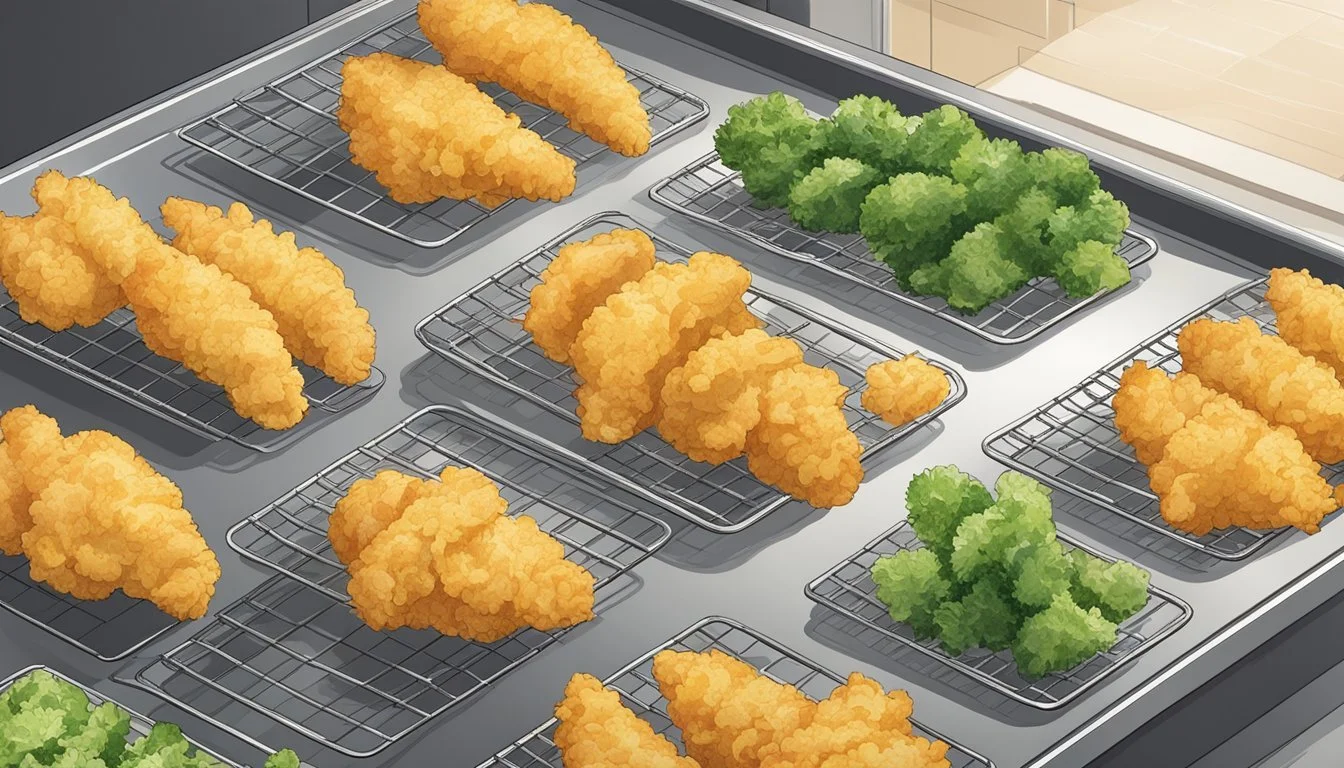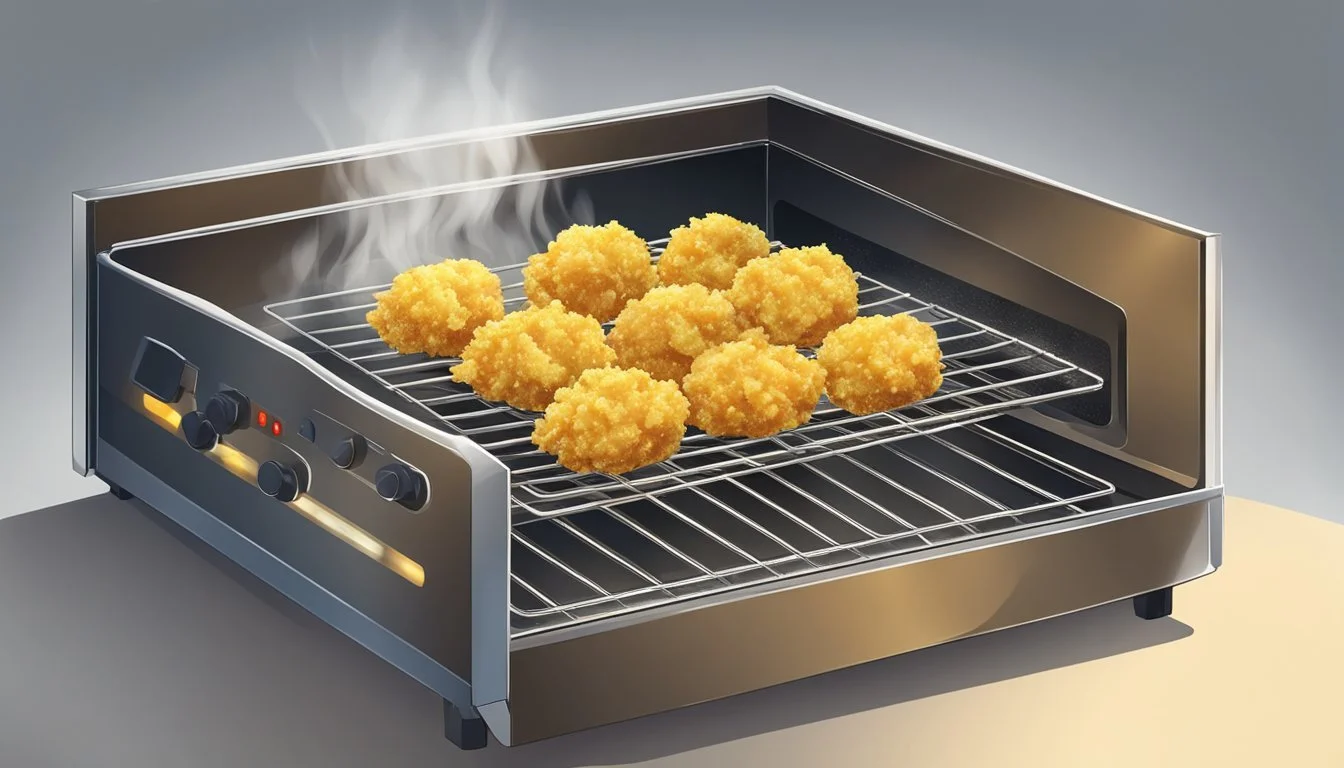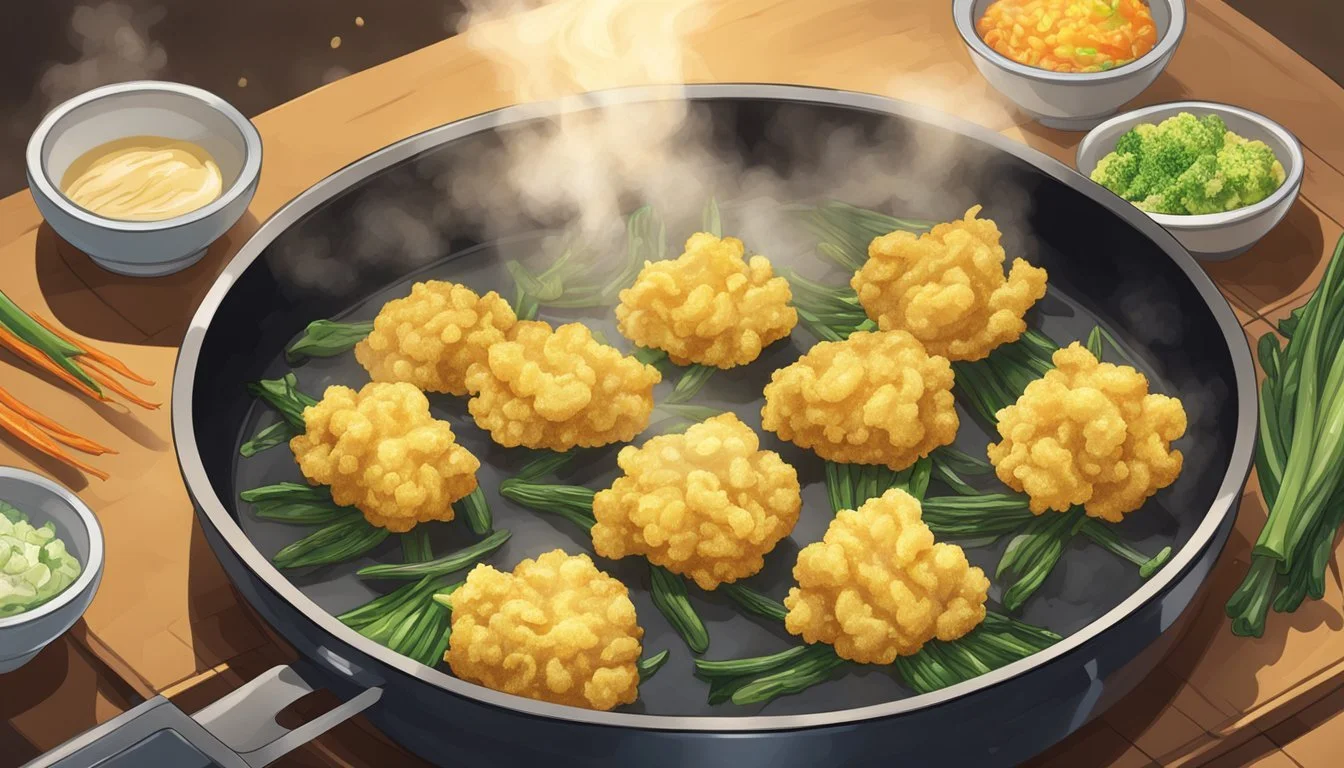Best Way to Reheat Tempura Vegetables
Ensuring a Crisp, Light Batter
Tempura vegetables are a staple in Japanese cuisine, known for their delicate, crispy batter. When reheated properly, tempura can retain the light, airy texture that makes it so enjoyable. The key to achieving this result lies in the reheating method chosen. Not all techniques will preserve the unique qualities of tempura; some can leave it either too soggy or overdone.
The challenge with reheating tempura vegetables is to warm them through without compromising the crispiness of the batter. Traditional methods like microwaving can lead to disappointing results, as the rapid heating often saps the moisture from the batter, leaving it chewy rather than crisp. Therefore, finding the best way to reheat tempura requires careful consideration of the methods that will restore the heat without dampening the crunch.
Understanding Tempura
Tempura is a Japanese dish known for its light yet crispy batter and is often served as golden brown vegetables or seafood. Mastery over the tempura batter and cooking technique is essential for achieving the ideal texture and flavor.
Essentials of Tempura Batter
The tempura batter is fundamental to the dish's characteristic light and crispy texture. It typically consists of cold water, wheat flour, and sometimes an egg or egg yolk. The cold temperature is crucial as it prevents gluten from developing, which would otherwise result in a heavy and doughy batter. Ingredients must be mixed minimally; overmixing can again lead to gluten formation, making the batter dense and compromising the crispiness.
Key Ingredients of Tempura Batter:
Cold water
Wheat flour
Egg (optional)
Preparation Tips:
Avoid overmixing to maintain lightness.
Chill the batter before use to keep it crispy.
Characteristics of Perfectly Cooked Tempura
Perfectly cooked tempura should have a golden brown color, indicating it has been fried at the right temperature. The batter surrounding the vegetables must be thin but crispy, allowing the natural flavors and textures of the vegetables to shine through. Nutritionally, though tempura involves deep-frying, the swift cooking process and light batter do not absorb excessive oil, thereby not overwhelming the vegetables' nutrition.
Tempura Cooking Indicators:
Color: Golden brown
Texture: Light and crispy batter
Flavor: Enhances, not overshadows, the natural flavors
Properly fried tempura is achieved by maintaining oil at a consistent high temperature, which ensures quick cooking and prevents oil absorption, maintaining the nutritional integrity of the ingredients. The ideal temperature range is between 340°F and 360°F for vegetables, to create that crispy batter without overcooking the interior.
Pre-Reheating Tips
Ensuring that tempura vegetables retain their light and crispy texture after reheating starts with proper pre-reheating practices. These include correct storage methods and ways to prevent sogginess before the reheating process begins.
Proper Storage of Tempura
Storing Tempura: To maintain the quality of leftover tempura, one should place the pieces in an airtight container. This prevents moisture and other contaminants from affecting the texture and taste.
Location: Store the airtight container in the refrigerator.
Duration: Properly stored tempura can last for 1-2 days without a significant loss in quality.
Avoiding Sogginess
Preventing Soggy Tempura: The enemy of crispiness is moisture. To avoid sogginess:
Allow the tempura to cool down completely before storage to prevent steam from building up.
Paper Towels: Line the container with paper towels to absorb any excess oil and moisture.
Utilizing these tips will set the stage for reheating tempura so that it retains as much of its original texture and flavor as possible.
Reheating Tempura in the Oven
Reheating tempura in the oven utilizes dry heat which helps maintain crispiness. The even distribution of hot air ensures that the batter does not become soggy.
Step-by-Step Oven Reheating
Preheat the oven to 425 degrees Fahrenheit to ensure a hot environment for reheating.
Prepare a baking sheet by lining it with parchment paper. This prevents sticking and absorbs excess oil.
Arrange the tempura vegetables on the baking sheet. They should be spaced out to allow heat circulation.
Heat the tempura in the preheated oven for 3-5 minutes. Heating time may vary depending on the oven and the size of the tempura pieces.
Ensuring Even Reheat
Monitor the tempura frequently during reheating to prevent burning, as ovens can vary in temperature.
Turn the tempura pieces halfway through the heating process to promote an even reheat. This step ensures the batter remains light and crisp on all sides.
Using the Air Fryer for Tempura
The air fryer method is a popular choice for reheating tempura to restore its light and crispy texture. By utilizing the convection mechanism, the air fryer revives the tempura without the sogginess that other reheating methods might introduce.
Air Fryer Reheating Process
One should preheat the air fryer to 350°F (175°C) before inserting the tempura. Tempura pieces must be spread out in a single layer to ensure even reheating. The duration for reheating is typically between 3 to 5 minutes. It's important to flip the tempura halfway through the process to guarantee even exposure to the air fryer's heat.
Preheat the air fryer to 350°F (175°C).
Arrange tempura in a single layer in the basket.
Reheat for 3 to 5 minutes.
Flip each piece of tempura halfway through the reheating time.
Optimizing Crispness
To bring back the desirable crunch to the tempura's batter, one might opt for a light coating of cooking spray before reheating. This step, combined with the hot circulating air of the air fryer, ensures that the tempura regains its crispy texture. It's crucial to avoid overcooking as it can dry out the tempura and diminish its quality.
A thin layer of cooking spray or oil can be applied before reheating.
Monitor closely to prevent overcooking.
The end result should be evenly heated and crisp tempura.
Using an air fryer to reheat tempura vegetables efficiently restores their freshness and maintains the lightness of the batter. Through careful attention to temperature and timing, one can enjoy tempura that is reminiscent of its original state.
The Microwave Method
While using a microwave to reheat tempura vegetables provides a quick solution, it often sacrifices some crispness in the process. However, with a few precautions, one can still enjoy sufficiently warmed tempura with a reasonable texture.
Mitigating the Microwave's Downsides
The microwave heats food by agitating water molecules, which can lead to sogginess if not managed correctly, especially in a batter-like tempura. To combat this:
Layer a Paper Towel: Place a paper towel onto a microwave-safe plate before laying out the tempura pieces. The towel will absorb excess moisture.
Heat in Short Bursts: Start by heating the tempura for 30 seconds on a medium power setting, check its warmth and crispness, then continue in 15-second intervals to avoid overheating.
Microwave Power: Lower power settings are preferable, as they heat food more evenly and reduce the chances of spots becoming too tough or soggy.
Standing Time: Allow the tempura to sit for a minute after microwaving, as this helps the heat distribute more evenly and restores some crispness.
By following these steps, they should help individuals to enjoy their reheated tempura vegetables while maintaining as much of the original texture as possible.
Alternative Reheating Techniques
For those seeking to avoid the microwave while reheating tempura vegetables, stovetop and toaster oven reheating present convenient solutions that can keep the batter light and crispy.
Stovetop Reheating
One can reheat tempura on the stovetop using a pan with hot oil, ideally vegetable oil, as it has a neutral flavor. It's important to heat the oil on medium heat to achieve an optimal balance of crispiness without overcooking. Reheaters should carefully place the tempura in the pan once the oil is hot and fry for about 1-2 minutes on each side or until the batter regains its crispness. It is essential to monitor the tempura closely, as they can brown quickly.
Materials Needed: Frying pan, vegetable oil
Method:
Heat a small amount of vegetable oil in the pan over medium heat.
Place tempura pieces in the oil, ensuring they do not touch.
Fry each side for 1-2 minutes.
Remove and drain on paper towels.
Toaster Oven Usage
Toaster ovens are an effective alternative to reheating tempura without using oil. Reheaters should preheat their toaster oven to approximately 350°F. It is suggested to place the tempura on a baking sheet or toaster oven rack to allow heat to circulate around each piece. The tempura should be heated for 3 to 5 minutes, flipping halfway through to ensure even warmth throughout.
Materials Needed: Toaster oven, baking sheet or rack
Method:
Preheat toaster oven to 350°F.
Arrange tempura on a baking sheet or oven rack with space in between.
Heat for 3-5 minutes, flipping halfway through.
By employing either stovetop or toaster oven techniques, reheaters can maintain the quality of tempura vegetables and enjoy a result that closely mimics the original texture and taste.
Food Safety and Best Practices
When reheating tempura vegetables, maintaining the quality and safety of the food is paramount. Achieving the delicate balance of crispiness without compromising on safety necessitates following proper storage and reheating protocols.
Handling Leftovers Safely
Storage: Leftover tempura should be stored in a refrigerator at or below 40°F within two hours of cooking to prevent bacterial growth. Tempura should be placed in shallow airtight containers to maximize cooling efficiency.
Refrigeration Duration: To ensure food safety, consume refrigerated tempura vegetables within 3-4 days.
Reheating: Always reheat leftovers to an internal temperature of 165°F, as measured by a food thermometer, to ensure they are safe to eat.
Best Oils for Reheating
Reheating tempura vegetables requires an oil with a high smoking point to avoid burning. Suitable oils include:
Peanut Oil: With a smoking point of 450°F, peanut oil is ideal for achieving a crispy, non-greasy texture while ensuring the tempura batter doesn't absorb excess oil.
Canola Oil: A smoking point of approximately 400°F makes canola oil another good choice for reheating while keeping the tempura light and crispy.
Sesame Oil: While it imparts a distinct flavor, sesame oil has a lower smoking point and should be used sparingly or mixed with oils with higher smoking points for reheating.
To maintain the integrity and safety of the food, it is crucial to monitor the temperature of the oil during reheating, avoiding overheating which may lead to the breakdown of oils and the formation of harmful compounds.
Serving Reheated Tempura
When serving reheated tempura vegetables, one should consider the appropriate accompaniments that will enhance the dish. The crispiness of the batter after reheating is complemented well by the right dipping sauces and thoughtful presentation alongside suitable side dishes.
Dipping Sauce Pairings
To harmonize with the light, crunchy texture of tempura, dipping sauces should bring a balance of flavor without overpowering the delicate batter. Here are specific sauces that can be paired with the tempura:
Tentsuyu (Traditional Dipping Sauce): A mixture of dashi broth, mirin, soy sauce, and often grated daikon radish, tentsuyu is the classic choice for tempura.
Ponzu Sauce: For a citrusy zest, ponzu sauce, which is soy sauce with a splash of yuzu or lemon juice, complements the tempura's crispness.
Spicy Mayo: A combination of mayonnaise with sriracha or another chili sauce can add a creamy kick that contrasts nicely with the vegetables' batter.
Side Dishes and Presentation
The presentation of tempura should highlight its crispiness and the variety of the vegetables. To maintain the integrity of the dish, it is essential to serve it immediately after reheating. Here are ideas for side dishes and ways to present them:
Rice: Serve the tempura over a bed of fluffy, steamed white rice for a filling meal.
Ginger and Radishes: Garnish with thinly-sliced pickled ginger and fresh radish to add crunch and a refreshing palate cleanser between bites.
Presentation: Serve on a bamboo mat or a simple, elegant plate to keep the focus on the tempura. Place them so they do not touch each other to ensure the batter remains airy and light.
Above all, the immediacy of serving reheated tempura cannot be overstressed; to retain the desired texture and warmth, tempura should be brought to the table as soon as it is ready.
Long-Term Storage Solutions
When preserving tempura vegetables, it's crucial to maintain their texture and flavor. For long-term storage, freezing offers a viable solution, allowing one to enjoy tempura at a later date without a significant compromise on taste or crispness.
Freezing and Reheating Tempura
Freezing Tempura: To freeze tempura vegetables, one should first let them cool completely post frying. They can then be arranged in a single layer on a baking sheet and frozen until solid to prevent sticking. Once solid, the pieces should be transferred to airtight containers or freezer bags, labeled with the date.
Reheating Frozen Tempura: For optimal results, tempura vegetables should be reheated from frozen without thawing first. An air fryer or oven is recommended over a microwave to keep the batter light and crisp.
Air Fryer: Preheat to 350°F (175°C), cook the frozen tempura for about 3 to 4 minutes.
Oven: Preheat to 350°F (175°C), bake the frozen tempura on a wire rack over a baking sheet for about 10 minutes.
Thawing Techniques
While it's typically best to reheat tempura directly from the freezer, should one need to thaw them, there are methods to minimize sogginess:
Refrigerator Thawing: Place the frozen tempura in the refrigerator a few hours before reheating. This slower thawing process helps maintain texture.
Room Temperature Thawing: Should time not permit refrigerator thawing, one may thaw tempura at room temperature for a shorter period. However, care should be taken to reheat them promptly after thawing to prevent bacterial growth.
Advanced Tempura Topics
When reheating tempura vegetables, understanding the impact on various ingredients and addressing related FAQs ensures the batter remains light and the ingredients retain texture.
Impact of Reheating on Various Ingredients
Different ingredients respond to heat in unique ways. Here's how common tempura components fare during reheating:
Shrimp and Fish: Seafood can become tough if overheated. Reheat gently and monitor closely.
Root Vegetables: Such as sweet potatoes and daikon radish can withstand longer reheating times due to their dense nature.
Broccoli: Should be reheated minimally to maintain its crunch and bright color.
Ingredient Reheating Consideration Shrimp Heat gently to avoid toughness Fish Monitor closely to prevent drying out Root Vegetables Can endure longer reheating times Broccoli Reheat minimally for crunchiness
Reheating Related FAQs
Q: Can I reheat tempura containing wasabi?
A: Wasabi may lose some of its pungency when reheated, it's better to add fresh wasabi after reheating.
Q: How do I prevent the batter from becoming soggy during reheating? A: Reheat on a wire rack to allow air circulation and prevent steam buildup which can cause sogginess.





